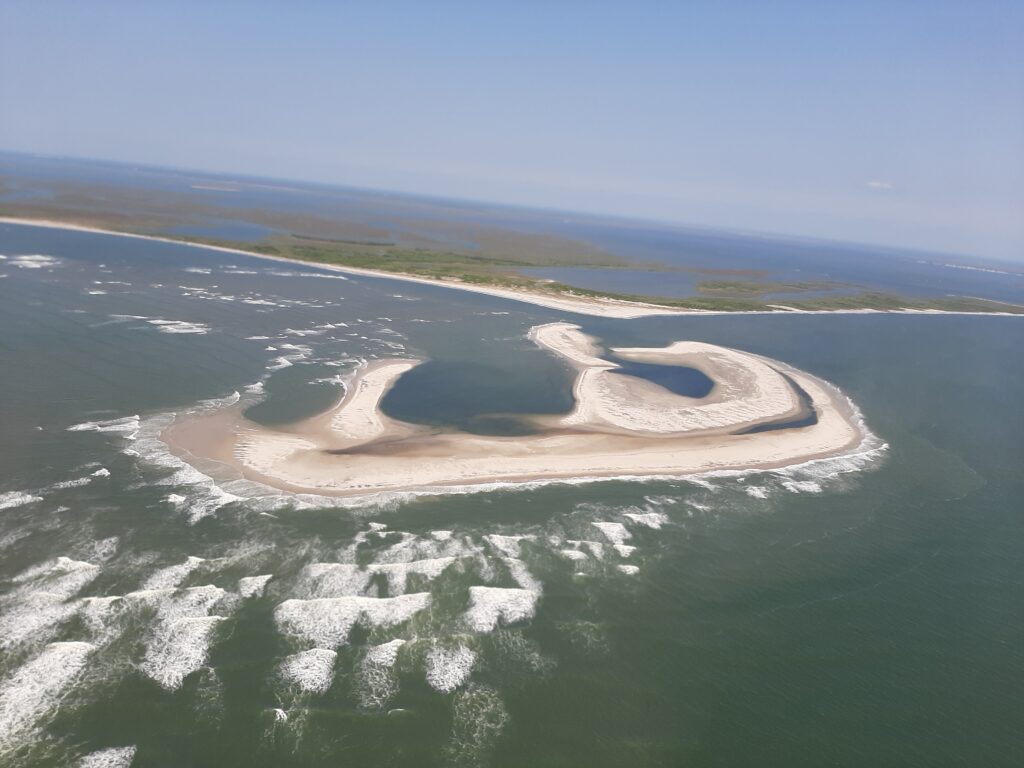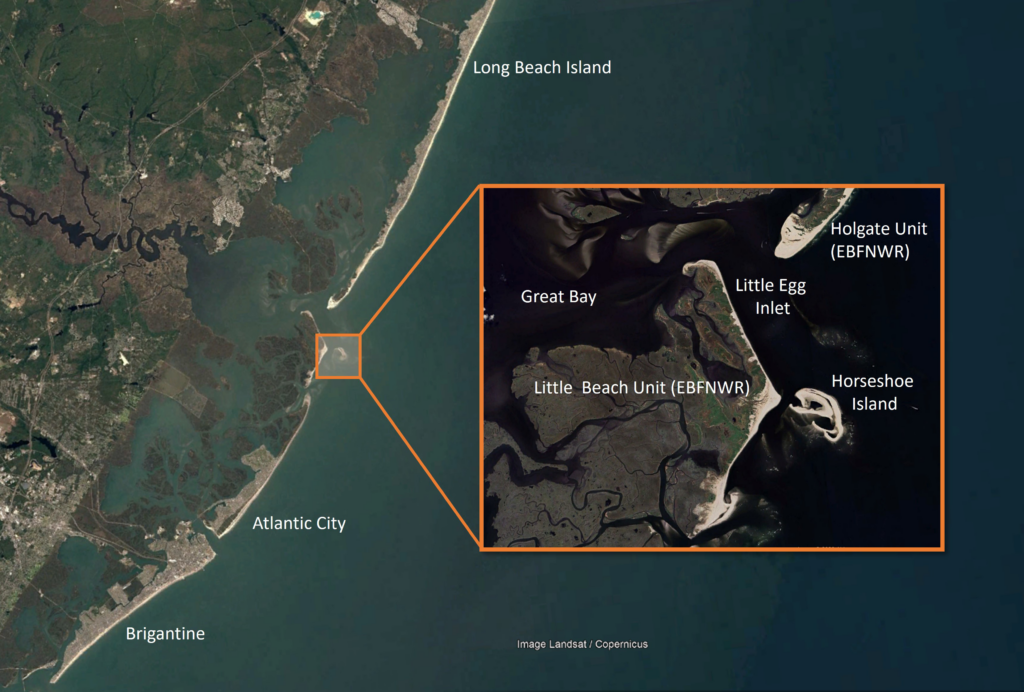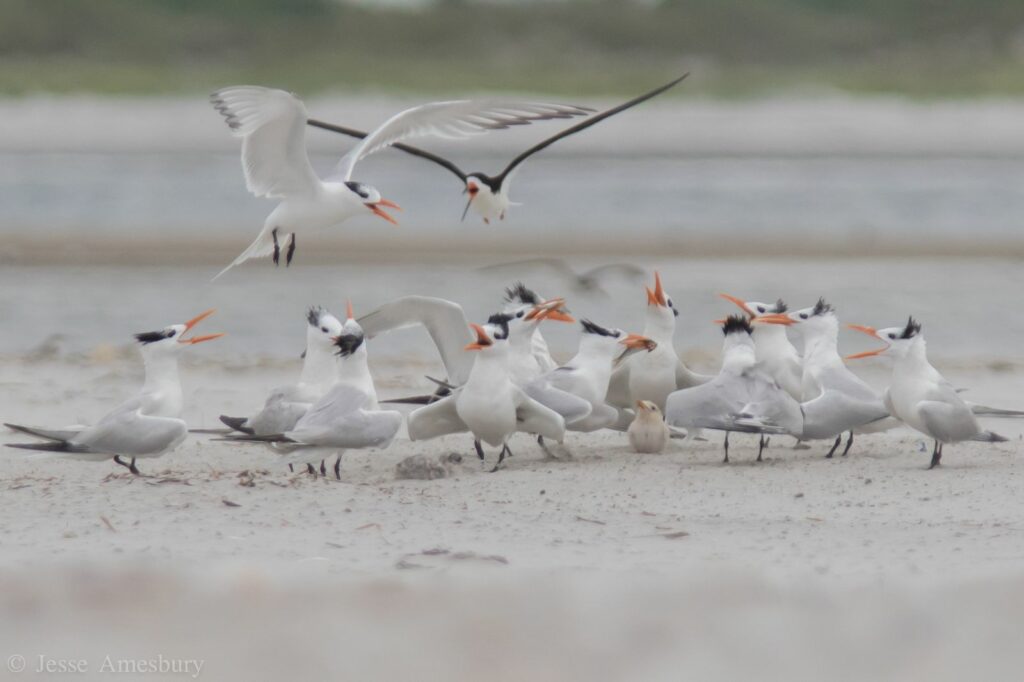
Background of Land Use Near the Little Egg Inlet
The area that comprises both Little Egg and Brigantine Inlets in Atlantic County is one of the most dynamic ecosystems in New Jersey. It includes the only undeveloped and unmanaged inlets for over 100 miles. Little Egg Inlet intersects critically important habitat located within the Edwin B. Forsythe National Wildlife Refuge (Refuge), managed by the U.S. Fish and Wildlife Service (USFWS), which also holds a National Wilderness Area. The western side of this inlet is adjacent to the New Jersey Fish and Wildlife’s (NJFW) Great Bay Boulevard Wildlife Management Area, and the Jacques Cousteau National Estuarine Research Reserve overlays this area. The barrier islands, marshes, and intertidal shoals in the region harbor numerous plants and animals of conservation concern including all Endangered Species Act-listed coastal-dependent species native to New Jersey: seabeach amaranth, piping plover, red knot, black rail, and roseate tern as well as numerous state endangered and threatened species (including black skimmer and least tern).
The sites adjacent to the Little Egg Inlet (Holgate to the north and Little Beach Island to the south [see Figure 2 below]) have been recognized as important habitat for beach-nesting birds since at least the 1950s. When Refuge biologists documented use by the birds in the 1970s, none of the habitat on Holgate was closed to public use and boating, beach-buggy riding, camping, and fires were common forms of recreation. When the piping plover was listed as federally threatened under the Endangered Species Act in 1986, Refuge staff and the NJFW agreed to enact a partial closure of the sites which developed into the full closure to all uses (April through August) that is still in place today.
The habitat within the Refuge is designated as a Wetland of International Importance by the Ramsar Convention and is a Western Hemisphere Shorebird Reserve Network site. The Holgate Unit of the Refuge is also classified as an Important Bird Area, with global priority, by the National Audubon Society.

The New Jersey Wildlife Action Plan (NJWAP, March 2018) provides guidance for management priorities within the NJFW. The Little Egg Inlet area features prominently in the Great Bay Region Conservation Focal Area and is noted as being “dominated by the most critical coastal habitat remaining in the state.” The Refuge and Horseshoe Island are included as a part of the area mapped for the proposed critical habitat designation for red knot, posted in the Federal Register by the Department of the Interior on July 15, 2021.
Creation of a New Island
While the dynamic nature of the Inlet has moved sand in the region and constantly changes the shorelines of Holgate and Little Beach Island, year-round use by migratory and nesting shorebirds has been constant. The need for human disturbance-free habitat increases each year as beaches along the Atlantic Coast experience heavy recreational use and are managed (via beach raking, among other actions) in a way that removes natural features and the food resources that birds require to survive.
Over the last seven years, sand that appears to have collected as a result of the natural southward longshore drift along Long Island Beach has been “coming and going” to form shoals just offshore of the Refuge’s Little Beach Island in the Atlantic Ocean. Natural processes have re-formed the site multiple times; however, by spring 2018, an emergent swash platform shoal formed and remained intact through all tide cycles. Aerial images and surveys by Stockton University Coastal Research Center suggest there was no nesting in 2018 or 2019, although migratory birds likely utilized the site for foraging and roosting. Nesting may have occurred in 2020, but the site was not surveyed by biologists to confirm that (due to the global COVID-19 pandemic).

A Haven for Nesting and Migratory Birds is Created
In May 2021, biologists confirmed that shorebirds and waterbirds were using the site for breeding and migration. For the remainder of that season, staff from the NJFW’s Endangered and Nongame Species Program and the Conserve Wildlife Foundation of New Jersey (with support from E.B. Forsythe National Wildlife Refuge) monitored the site each week until all nesting was complete in mid-September.
The island, which originally formed in the shape of a horseshoe, is incredibly important for many bird species. Between 2021-24, it provided:
- Nesting habitat for 3 pairs of breeding piping plovers (federally threatened, state endangered) and as many as 31 individuals at a time during migratory stopovers.
- Nesting habitat for up to 16 pairs of breeding American oystercatchers (state species of special concern) and roosting habitat for over 300 individuals in the non-breeding season.
- Nesting habitat for up to 370 least terns (state endangered), making it one of the largest colonies in the state.
- Nesting habitat for up to 2,000 black Skimmsrs (state endangered) and one of just a handful of known colonies in the state.
- Nesting habitat for up to 560 common terns (state species of special concern).
- Nesting habitat for up to 1,200 royal terns, making it the northernmost record of a royal tern colony in the northern hemisphere, and roosting habitat for hundreds more individuals.
- Roosting habitat for up to 700 red knots (federally threatened, state endangered).
- Roosting habitat for up to 250 brown pelicans.
- Roosting and foraging habitat for numerous other avian species, including roseate tern (federally endangered, state endangered), whimbrel, black-bellied plover, semipalmated plover, sanderling, and ruddy turnstone.
The use of this island is truly unprecedented in this part of New Jersey in terms of avian species diversity and abundance, particularly among species of conservation concern. Many of the species are endangered or threatened, and in addition, the NJWAP identifies piping plover, red knot, black skimmer, least tern, common tern, and American oystercatcher as Focal Species of Greatest Conservation Need in the State of New Jersey. As the island persists, wildlife diversity and abundance are expected to increase.
Challenges for Wildlife
In 2021, Horseshoe Island persisted through all tide cycles. As summer progressed, public use increased dramatically as boaters landed on the shores of the site. While biologists installed small signs to mark off areas most-used by birds, unleashed dogs, people walking through important habitats, and use of the lagoon by jet skis was observed. As is indicated in the NJWAP, boating and use of beaches at sites such as Horseshoe Island are considered threats. Furthermore, it is well-known that human disturbances are a serious threat to nesting bird species on beaches (Megnak et al., 2019).
Management Rights Agreement is Approved
In early 2022, managers and biologists responsible for the well-being of coastal bird species in New Jersey requested a Management Rights Agreement from the Tidelands Resource Council to allow for management of the island and its intertidal areas for nesting and migratory birds. The site may be ephemeral, but research of similarly formed islands in Virginia, North Carolina, and South Carolina suggests that as long as the site persists, it will be highly desirable habitat for avian species. Today, Horseshoe Island is one of the most critically important areas for birds in the State of New Jersey.
In February 2022, The Tidelands Resource Council voted to assign management rights of Horseshoe Island to the NJFW and the Refuge, including a seasonal closure of March 1-September 30 for a period of 5 years. Biologists will survey and study bird use of the site to share information in the future (2024 Report ).
Management Objectives, Key Points, and Strategies
Objective: Provide undisturbed habitat for shorebirds and seabirds to support their nesting and migratory periods via a March 1-September 30 closure of Horseshoe Island to the public. No access or recreational activity is permitted on the site during that time each year for 5 years – beginning in 2022.
Key Points:
- Beginning in 2022, Horseshoe Island will be closed to all uses March 1 through September 30.
- Shorebirds use these coastal habitats year-round. Some pass through NJ on northbound (March – June) and southbound migrations (August-October). Some breed here (April-September) and others winter here (October-April). There is no period of the year where shorebirds are not present in the state, actively seeking and utilizing habitat for foraging, roosting, or breeding.
- In 2021, nearly 4,900 acres of Atlantic Coast beach habitat occurred in the State of New Jersey. Of that, less than 4% (180 acres of beach) was fully closed (no public access permitted at any time) year-round for the benefit of wildlife, military operations, or safety concerns. The vast majority of beaches are fully or partially open to the public, causing disturbance from human activity and conflicts with user groups.
- Biologists anticipate bird use of the site to continue to increase in the future if the land mass remains intact and undisturbed. Horseshoe Island is very near to the Edwin B. Forsythe National Wildlife Refuge, which benefits birds as they move between sites for different life functions. For example, in 2024 the Refuge hosted 48 pairs of piping plovers, which is the highest population in the state. In 2024, plover set up nesting territories on the new island, which provides opportunity for the bird’s population to increase in a manner that is extremely rare in New Jersey – through the creation of new habitat.
- The new island (≤ 1,000 feet away from Little Beach Island) is co-managed by the NJFW and Refuge. The seasonal closure should eliminate disturbance by the public, who have a variety of other ways to enjoy the coastal environment.
- Management of all shorebird species is the responsibility of both the NJFW and the USFWS. NJFW’s authority is provided by the Endangered and Nongame Species Conservation Act (NJSA 23:2A-1 to 23:2A-1:16). The USFWS is responsible for ensuring implementation of the Migratory Bird Treaty Act (16 U.S.C. §§ 703–712) and the Endangered Species Act (16 U.S.C. § 1531).
Management Strategies:
- Provide outreach to the public about the importance of the site to nesting, wintering, and migratory birds.
- Provide education through onsite signage
- Use mass media and social media to conduct outreach
- Create and distribute fliers, brochures, and pamphlets to the public and within the communities located on Long Beach Island
- Communicate importance of the closure to town councils and community organizations
- Conduct oral presentations in nearby communities
- Increase state and federal presence at the island to educate the public about the importance of the site, especially during summer recreation periods (typically May-August).
- NJFW biologists will work with NJFW law enforcement to support patrols of the island, especially during peak periods of boater usage on busy holidays and weekends.
- Officers and biologists may hand out pamphlets to aid on-the-spot communication.
- Protect and monitor wildlife populations
- Each year, NJFW and the Refuge (via Conserved Wildlife Foundation of New Jersey) will develop a monitoring plan to collect data on bird use of the site. The monitoring plan will strongly focus on breeding season data for endangered species but will also collect data on migratory and wintering use, as possible. This data will assist in decisions around management (for predators, for example) and will contribute to the overall understanding of population dynamics for each species utilizing the site.
- NJFW will post signage and fencing on-site, as needed.
- NJFW will collate data annually for inclusion in its Biotics database and in the Landscape Project to ensure a permanent record of the data is maintained and that the natural resources of the site are offered protection if land use and regulatory issues arise.
Previous Year’s Reports
Contact Information
NJ DEP Fish and Wildlife – Endangered and Nongame Species Program
609-628-2103 or nongame@dep.nj.gov
USFWS – Edwin B. Forsythe NWR
609-652-1665 or forsythe@fws.gov
Additional Materials
- Horseshoe Island 2024 Update
- Horseshoe Island 2022
- 2017-2023 Horseshoe Island Evolution – Zoomed In
- 2017-2023 Horseshoe Island Evolution – Zoomed Out
Citations
New Jersey Fish and Wildlife. 2018. New Jersey State Wildlife Action Plan.
Mengak, L., A.A. Dayer, R. Longenecker, and C.S. Spiegel. 2019. Guidance and Best Practices for Evaluating and Managing Human Disturbances to Migrating Shorebirds on Coastal Lands in the Northeastern United States. U.S. Fish and Wildlife Service.
 Official Site of The State of New Jersey
Official Site of The State of New Jersey
